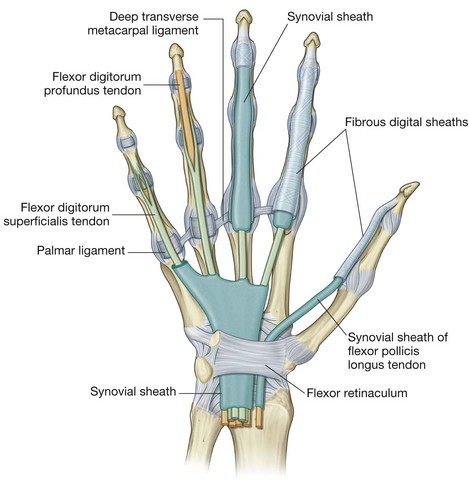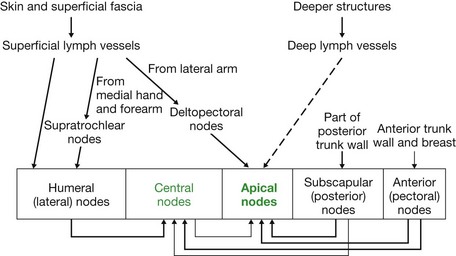Chapter 19 Upper limb pain
Case 19.1
1. Redness, swelling and pain are typical of inflammation and/or infection. What structure is likely to be infected?
2. Will the infection spread quickly into the hand? Give reasons for your answer.
Not especially, as the synovial flexor sheath in the index finger is not continuous with the common synovial sheath in the hand itself. Refer to Figure 19.1.
3.
a If the infection had commenced in the thumb, what structure may have been rapidly infected?


Figure 19.1 Synovial sheaths of the hand
(Source: Drake R, Vogl A, Mitchell A. Gray’s Anatomy for Students [2nd edn]. Philadelphia: Churchill Livingstone; 2010: 760, Fig 7.98)
The common synovial sheath in the hand and then the wrist, due to the continuity of the sheath from the thumb. Refer to Figure 19.1.
Case 19.2
2. Name the muscles attached to the lateral epicondyle. At which joints do they act?
• Extensor digitorum (ED) — wrist, mid-carpal, metacarpophalangeal and interphalangeal joints of digits 2–5.
Case 19.3
2. What is the name given to the redness on her hands? Name the causes of this sign.
Palmar erythema. Causes include:
3. Can you see any evidence in the photograph which would help you determine the cause of the redness in this particular individual?
4. What other clinical features might she have or develop later?
If the diagnosis is rheumatoid arthritis:
• Spindle-shaped swellings of metacarpophalangeal and proximal interphalangeal joints are most common, and are described as ‘boggy’ in texture and tender to touch.
• Other joints that may be affected include: knees, wrists, elbows, ankles and cervical spine (this is the most commonly affected region of the spine with rheumatoid arthritis, however, it is a late manifestation of the disorder, and usually occurs in patients with advanced disease).
• Deformities include subluxation of joints, fixed flexion of digits, and medial deviation of the fingers (called ulnar deviation).
• There is a tendency for rheumatoid arthritis to become quiescent after remaining active for months or years. In most cases there is permanent impairment of joint function. In certain joints, especially in the knees, degenerative changes are often superimposed upon the previous rheumatoid condition, and lead to increasingly severe disability even though the original rheumatoid affection is no longer active.
• Articular complications:
 ongoing synovitis of the upper cervical zygapophyseal joints produces loosening and destruction of the transverse ligaments with subsequent atlanto-axial subluxation
ongoing synovitis of the upper cervical zygapophyseal joints produces loosening and destruction of the transverse ligaments with subsequent atlanto-axial subluxation
 ongoing synovitis of the upper cervical zygapophyseal joints produces loosening and destruction of the transverse ligaments with subsequent atlanto-axial subluxation
ongoing synovitis of the upper cervical zygapophyseal joints produces loosening and destruction of the transverse ligaments with subsequent atlanto-axial subluxation• Extra-articular complications:
 Pleural involvement is the most common. Pulmonary manifestations rarely compromises respiratory status. Bronchial disease is also common. Interstitial lung disease is seen more frequently in men. Symptoms of this condition include dyspnoea and a non-productive cough.
Pleural involvement is the most common. Pulmonary manifestations rarely compromises respiratory status. Bronchial disease is also common. Interstitial lung disease is seen more frequently in men. Symptoms of this condition include dyspnoea and a non-productive cough.
 Rheumatoid vasculitis: one of the most serious complications of rheumatoid arthritis. Cutaneous, neurological, pulmonary, and gastrointestinal involvement comprise the spectrum of vasculitis.
Rheumatoid vasculitis: one of the most serious complications of rheumatoid arthritis. Cutaneous, neurological, pulmonary, and gastrointestinal involvement comprise the spectrum of vasculitis.
 Ophthalmologic: complications in patients with rheumatoid arthritis include corneal involvement. Keratoconjunctivitis sicca or dry eyes is the most common eye complaint in rheumatoid arthritis patients. This manifestation of Sjögrens syndrome can cause corneal scarring and decreased visual acuity if ulcers and infections are allowed to develop. Scleritis can cause pain, thinning of the sclera and ultimately perforation and blindness.
Ophthalmologic: complications in patients with rheumatoid arthritis include corneal involvement. Keratoconjunctivitis sicca or dry eyes is the most common eye complaint in rheumatoid arthritis patients. This manifestation of Sjögrens syndrome can cause corneal scarring and decreased visual acuity if ulcers and infections are allowed to develop. Scleritis can cause pain, thinning of the sclera and ultimately perforation and blindness.
 Felty’s syndrome: classified as a classic triad of rheumatoid arthritis, splenomegaly, and granulocytopaenia. Many rheumatoid arthritis patients have rheumatoid nodules and other extra-articular manifestations of their disease such as vasculitis. Some patients with this syndrome suffer recurrent bacterial infections.
Felty’s syndrome: classified as a classic triad of rheumatoid arthritis, splenomegaly, and granulocytopaenia. Many rheumatoid arthritis patients have rheumatoid nodules and other extra-articular manifestations of their disease such as vasculitis. Some patients with this syndrome suffer recurrent bacterial infections.
 Pleural involvement is the most common. Pulmonary manifestations rarely compromises respiratory status. Bronchial disease is also common. Interstitial lung disease is seen more frequently in men. Symptoms of this condition include dyspnoea and a non-productive cough.
Pleural involvement is the most common. Pulmonary manifestations rarely compromises respiratory status. Bronchial disease is also common. Interstitial lung disease is seen more frequently in men. Symptoms of this condition include dyspnoea and a non-productive cough. Rheumatoid vasculitis: one of the most serious complications of rheumatoid arthritis. Cutaneous, neurological, pulmonary, and gastrointestinal involvement comprise the spectrum of vasculitis.
Rheumatoid vasculitis: one of the most serious complications of rheumatoid arthritis. Cutaneous, neurological, pulmonary, and gastrointestinal involvement comprise the spectrum of vasculitis. Ophthalmologic: complications in patients with rheumatoid arthritis include corneal involvement. Keratoconjunctivitis sicca or dry eyes is the most common eye complaint in rheumatoid arthritis patients. This manifestation of Sjögrens syndrome can cause corneal scarring and decreased visual acuity if ulcers and infections are allowed to develop. Scleritis can cause pain, thinning of the sclera and ultimately perforation and blindness.
Ophthalmologic: complications in patients with rheumatoid arthritis include corneal involvement. Keratoconjunctivitis sicca or dry eyes is the most common eye complaint in rheumatoid arthritis patients. This manifestation of Sjögrens syndrome can cause corneal scarring and decreased visual acuity if ulcers and infections are allowed to develop. Scleritis can cause pain, thinning of the sclera and ultimately perforation and blindness. Felty’s syndrome: classified as a classic triad of rheumatoid arthritis, splenomegaly, and granulocytopaenia. Many rheumatoid arthritis patients have rheumatoid nodules and other extra-articular manifestations of their disease such as vasculitis. Some patients with this syndrome suffer recurrent bacterial infections.
Felty’s syndrome: classified as a classic triad of rheumatoid arthritis, splenomegaly, and granulocytopaenia. Many rheumatoid arthritis patients have rheumatoid nodules and other extra-articular manifestations of their disease such as vasculitis. Some patients with this syndrome suffer recurrent bacterial infections.For more information, refer to the further reading section at the end of this chapter.
Case 19.4
1. Using only the information provided in Vicky’s history, list your differential diagnoses for her hand symptoms. Justify your answer.
| Possible diagnosis | Justification |
|---|---|
| DDx 1: carpal tunnel syndrome (carpal tunnel syndrome) | |
| DDx 2: thoracic outlet syndrome | |
| DDx 3: cervical disc herniation with radiculopathy | |
| DDx 4: pronator teres syndrome | |
| DDx 5: polyneuropathy |














